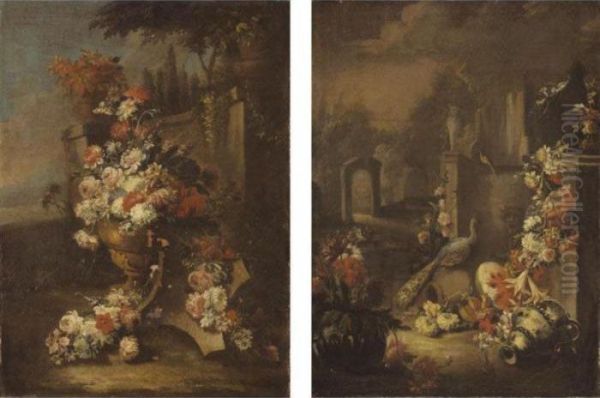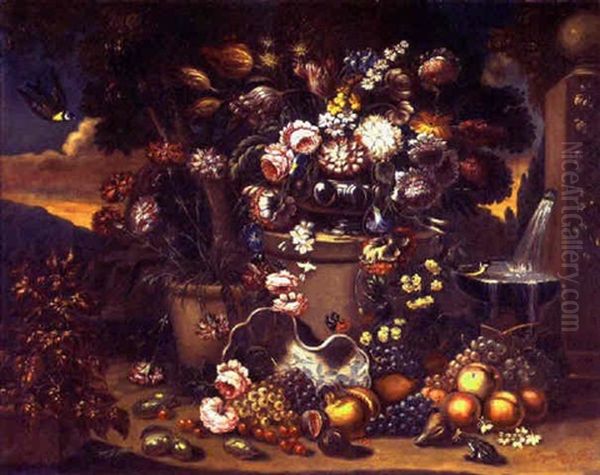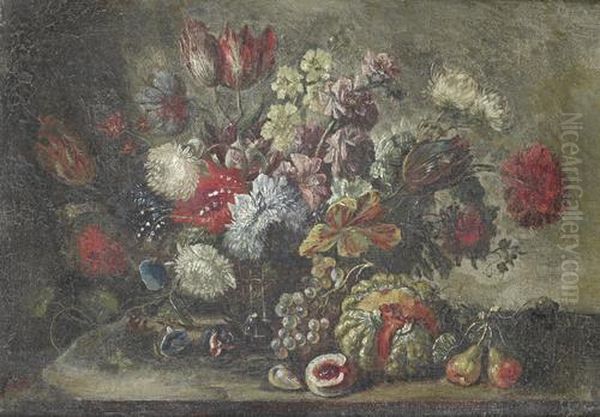Gasparo Lopez, often affectionately known by the moniker "Gasparo dei Fiori" (Gaspar of the Flowers), stands as a significant figure in the history of Italian still life painting. Born in Naples around 1650 and active until his death in 1732, Lopez navigated the transition from the dramatic intensity of the High Baroque to the lighter, more decorative sensibilities of the Rococo. His career unfolded across several major Italian artistic centers, including Naples, Rome, Venice, and ultimately Florence, where he achieved considerable recognition. Primarily celebrated for his vibrant and meticulously rendered flower paintings, Lopez's work captures the ephemeral beauty of nature while reflecting the sophisticated tastes of his era.
Neapolitan Roots and Artistic Formation
Naples, the city of Gasparo Lopez's birth, was a bustling metropolis and a major European art capital during the 17th century. The artistic environment was rich and complex, shaped by the legacy of Caravaggio's dramatic naturalism, the dynamic compositions of Spanish masters like Jusepe de Ribera, and the flourishing local school that included luminaries such as Luca Giordano and Mattia Preti. It was within this vibrant context that Lopez began his artistic journey. While the specifics of his earliest training remain somewhat obscure, historical sources indicate that he honed his craft under the guidance of notable masters.
Key figures cited as his teachers include Jean-Baptiste Dubisson (also referred to as Dubois, active c. 1660-1735) and the renowned Neapolitan still life specialist Andrea Belvedere (1652-1732). Dubisson, possibly of French or Flemish origin but active in Naples, likely imparted elements of Northern European precision and compositional structure. Belvedere, a leading figure in Neapolitan still life, was known for his lush, elaborate arrangements of flowers and fruit, often imbued with a sense of Baroque grandeur. Their combined influence would have provided Lopez with a strong foundation in the techniques and aesthetics of contemporary still life painting.

Beyond Naples, Lopez's artistic development was further enriched by periods spent in other important Italian cities. He is known to have worked or studied in Rome and Venice, centers that offered exposure to different artistic traditions and patrons. Rome, with its classical heritage and powerful papal patronage, fostered a grander, often more formal style. Venice, renowned for its mastery of color and light, particularly through artists like Titian and later Canaletto, offered a different sensibility. These experiences likely broadened Lopez's artistic vocabulary, allowing him to synthesize various influences into his mature style. There is also mention of time spent in Dresden, suggesting his reputation may have begun to spread beyond Italy early in his career.
The Flourishing of a Style: Baroque Grandeur Meets Rococo Grace
Gasparo Lopez specialized almost exclusively in still life, particularly compositions featuring flowers, earning him the nickname "Gasparo dei Fiori." His style is characterized by a fascinating blend of late Baroque dynamism and emerging Rococo elegance. He inherited the Baroque love for abundance, complex arrangements, and dramatic potential, often depicting cascades of blossoms spilling from ornate vases or arranged within landscape settings. However, his work increasingly displayed a lightness of touch, a preference for brighter palettes, and a decorative sensibility that aligned with the burgeoning Rococo aesthetic.
His compositions frequently move beyond simple tabletop arrangements. Lopez often situated his floral displays within broader contexts, incorporating elements like classical ruins, garden architecture, fragments of sculpture, or glimpses of landscapes. This integration of still life elements into a wider scene adds depth and narrative potential to his works. Pieces like his Still Life of Flowers and Fruit in an Antique Landscape exemplify this approach, where meticulously painted flowers and fruits are juxtaposed with weathered stone plinths and architectural fragments, creating a dialogue between the transient beauty of nature and the enduring presence of the past.
Lopez demonstrated exceptional technical skill. His rendering of individual flowers – tulips, roses, carnations, daisies, larkspur, convolvulus, snowballs – is precise and botanically observant, capturing the delicate textures of petals and leaves. He possessed a keen understanding of light and shadow, using it not just for dramatic effect in the Baroque manner, but also to create a sense of luminosity and airiness that feels distinctly Rococo. His color palettes are rich and varied, often employing vibrant hues that contribute to the overall decorative appeal of his paintings. This combination of detailed realism and decorative elegance made his work highly sought after.

The influence of French flower painting, particularly the opulent yet refined style associated with artists like Jean-Baptiste Monnoyer, is also discernible in Lopez's work. The French court style, emphasizing grace, decoration, and a certain joie de vivre, resonated with the evolving tastes across Europe, and Lopez skillfully incorporated these elements into his Neapolitan framework. His paintings often feature elaborate vases, swags of flowers, and a sense of cultivated abundance that would have appealed to aristocratic patrons seeking to adorn their residences.
Court Painter in Florence
A significant chapter in Gasparo Lopez's career unfolded in Florence. Having established a considerable reputation, he eventually settled in the Tuscan capital and attained the prestigious position of Hofmaler, or Court Painter, serving the Grand Ducal court, likely during the later Medici period. This appointment was a testament to his skill and renown, placing him in the direct service of one of Italy's most historically significant ruling families.
Working for the Florentine court would have involved creating paintings specifically tailored to the tastes and requirements of his patrons. His still lifes, with their inherent decorative qualities, were ideally suited for adorning the interiors of palaces and villas. The sophistication, elegance, and technical polish of his work aligned perfectly with the courtly environment. While specific commissions might be hard to trace precisely, his role as Hofmaler confirms his status as a leading painter of his time, recognized and valued at the highest levels of society.
His time in Florence likely further refined the Rococo elements in his style. Florence, while perhaps past its Renaissance peak, remained a city of immense cultural heritage and sophisticated patronage. The environment likely encouraged the lighter, more graceful aspects of his art. His works from this period probably continued to feature his signature floral arrangements, perhaps increasingly set against idealized landscapes or incorporating motifs popular in Florentine decorative arts. The documented appreciation of his works by Florentine collectors, evidenced by their inclusion in prestigious exhibitions like those held at Santissima Annunziata in 1737 and 1767 (shortly after his death), underscores his success in this demanding artistic center.
Representative Masterpieces

Several works stand out as representative of Gasparo Lopez's artistic achievement. Among the most frequently cited is the pair of paintings often titled Still Life of Flowers and Fruit in an Antique Landscape. Descriptions vary slightly but consistently point to large canvases (dimensions like 96 x 135 cm and 96 x 132 cm are mentioned) depicting opulent arrangements set amidst classical ruins. One description details a golden vase overflowing with tulips, roses, daisies, and white snowballs, accompanied by a watermelon and grapes. Another variation mentions a large vase on a stone base, grapes, a prominent mushroom-shaped container, and a profusion of flowers including large red roses. These works perfectly encapsulate his blend of naturalistic detail, Baroque composition, and evocative landscape settings.
Another key work is Composizione di fiori (Flower Composition), housed in the Museo di Palazzo Pretorio in Prato. This painting is noted for showcasing Lopez's mastery of floral arrangement, his delicate brushwork, and his skillful manipulation of light and shadow to define form and create atmosphere. Its presence in a significant public collection highlights its recognized importance.
The title Still life with larkspur, carnations, convolvulus and tulips points to another characteristic work, emphasizing his ability to capture the specific identities and delicate forms of various flower species within a harmonious composition. Similarly, works appearing in auction records under titles like Still Life in a Vase attest to the enduring appeal and market presence of his more focused floral studies. These paintings, whether grand compositions or more intimate studies, consistently demonstrate Lopez's dedication to the beauty of the botanical world, rendered with technical brilliance and stylistic elegance.
Artistic Context and Connections
To fully appreciate Gasparo Lopez's contribution, it is essential to place him within the broader context of Italian and European art. His training with Andrea Belvedere situated him firmly within the Neapolitan still life tradition, which had already produced significant talents like Giuseppe Recco and Paolo Porpora, known for their often dramatic and richly textured depictions of natural subjects, including fish and flowers. Lopez built upon this foundation, infusing it with a new elegance.
His relationship with Jean-Baptiste Dubisson connects him to the wider European network, potentially linking him to French or Flemish influences prevalent in Naples at the time. The general influence of French flower painters, exemplified by figures like Jean-Baptiste Monnoyer, is crucial. Monnoyer's work for the French court set a standard for decorative floral painting that resonated across Europe, and Lopez adapted this sensibility to his Italian context.
Comparisons are sometimes drawn with contemporaries like Antonio Gianlisi (active late 17th–early 18th century), another Italian still life painter. While both might share certain characteristics like elegant light and rich color, Lopez is often noted for achieving a greater level of detail and perhaps a stronger visual impact, pushing towards the Rococo aesthetic more decisively.
Looking forward, art historians have noted that Lopez's style, particularly his handling of light and his move towards a brighter, more atmospheric presentation, anticipates certain aspects found in the work of later 18th-century artists. The mention of his work echoing the "modernity and luminosity" of Francesco Guardi, the famous Venetian view painter, suggests that Lopez was not merely following trends but was part of a broader shift towards a lighter, more visually vibrant aesthetic that would characterize much of 18th-century painting. While distinct from the early Baroque intensity of Caravaggio or the high drama of Ribera, Lopez's work represents a vital evolution within the Italian tradition, influenced by predecessors like the Flemish master Jan Brueghel the Elder in its detailed rendering of flowers, but ultimately forging its own path.
Legacy and Historical Reception
Gasparo Lopez enjoyed considerable success during his lifetime, evidenced by his nickname "Gasparo dei Fiori," his appointment as court painter in Florence, and the appreciation of his work by collectors. His reputation endured after his death in 1732. The inclusion of his paintings in Florentine exhibitions in 1737 and 1767 demonstrates continued interest.
The provenance history of some of his works provides further insight into his reception. For instance, paintings formerly in the Martini collection found their way into the Palazzo Pretorio in Prato. Their subsequent journey, involving donations to charitable institutions like the Ospedale Misericordia and Dolce (or Donderini family), transfer to the municipality of Prato in 1873, cataloguing by figures like Carocci (in 1900 and 1912) and Papini, storage in the Civico Museum (from 1963), and eventual relocation to the Palazzo Comunale (in 2020), traces a path of sustained institutional and scholarly recognition over centuries.
Historically, Gasparo Lopez is valued as a key exponent of late Baroque and early Rococo still life painting in Italy, particularly within the Neapolitan school. He represents a crucial link between the more robust, dramatic style of the 17th century and the lighter, more decorative tastes of the 18th century. His ability to combine meticulous observation of nature with elegant composition and a refined sense of color secured his place in art history. His works continue to be admired in museums and private collections for their technical virtuosity and enduring decorative charm.
Conclusion
Gasparo Lopez, "Gaspar of the Flowers," remains a celebrated figure in Italian art history, renowned for his exquisite still life paintings. Emerging from the dynamic artistic milieu of late 17th-century Naples and refining his craft through exposure to Rome, Venice, and potentially Dresden, he developed a distinctive style that skillfully blended Baroque complexity with Rococo grace. His appointment as court painter in Florence marked the pinnacle of a successful career dedicated to capturing the vibrant beauty of the floral world.
Through masterpieces like Still Life of Flowers and Fruit in an Antique Landscape and Composizione di fiori, Lopez demonstrated not only his technical mastery in rendering petals, leaves, and light, but also his ability to create compositions that were both naturalistically convincing and highly decorative. Influenced by his teachers Andrea Belvedere and Jean-Baptiste Dubisson, as well as broader European trends, particularly from France, he forged a unique artistic identity. Remembered alongside contemporaries and influencing perceptions of the transition towards 18th-century aesthetics, Gasparo Lopez's legacy endures through his captivating paintings, which continue to delight viewers with their elegance, detail, and celebration of nature's bounty.